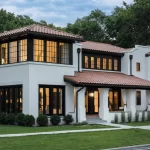
Plumbing and electrical are essential elements in building construction. Both these systems play a pivotal role in maintaining home structure and function. In this article we’ll look at various stages of plumbing and electrical work during new home building.
Use of the appropriate solder for every project is paramount to its success and safety. Plumbing solder is not appropriate for electrical projects and vice versa. Selecting an inappropriate solder could result in poor connections or even safety hazards, which should never be used without first consulting an expert.
Plumbing
Plumbing refers to the infrastructure consisting of pipes, fixtures, valves and fittings used to transport fluids (primarily water) between residential, commercial and industrial properties. Plumbers are essential members of this network; their responsibility includes installation, repair and maintenance work on plumbing systems.
Plumbing systems also contain drainage lines to transport wastewater away from homes to sewer systems. These drain lines should be sloped downward to help move it along its journey and rely on gravity to flush any dirt out of the home – which makes regular inspection and maintenance all the more important for efficient functioning of this aspect of plumbing systems.
At the rough-in phase of construction, plumbers will install both supply and waste pipe systems prior to erecting walls and ceilings in your home. This involves running pipes through studs and framing so they reach all sinks, faucets, toilets, and showers – then testing each system thoroughly to make sure that it complies with code and works optimally.
Electrical
At this phase of plumbing installation, workers install pipes carrying fresh and waste water as well as set up drainage. Furthermore, wiring for lighting, outlets and appliances is installed during this stage.
Electricians require strong mathematical, theoretical and other fundamental abilities in order to be successful at their trade. Electricians deal with blueprint reading, thread fitting and small gauges which requires them to flex their visual muscles and read blueprints regularly.
They must understand Ohm’s Law, which states that the current flowing through a conductor (like wire) equals its electromotive force (voltage), with resistance measured in ohms limiting how fast electricity moves along its course. Electricity must have complete circulation within its circuit in order to flow freely, and any interruption prevents it. That is why plumbing and electrical work should always be completed at once to ensure their proper coordination for optimal functionality and safety.
MEP
MEP engineering encompasses three disciplines – mechanical, electrical and plumbing engineering. Together these professionals collaborate closely to make buildings habitable for people by providing services like air conditioning, heating and ventilation as well as power supply systems. Furthermore, they optimize material requirements and reduce installation costs while meeting codes with high performance and meeting code compliance.
Engineers performing MEP analysis typically calculate heating and cooling loads to assess equipment capacities, as well as designing electrical circuits necessary for its safe, continuous operation. Plumbing installations involve intricate piping routes that may interact with both mechanical and electrical components within a building’s interior space, thus making this a complex undertaking.
Engineers utilize coordination drawings for each spool of ductwork and conduit to ensure seamless construction projects, and detect potential obstacles before being installed, saving costly corrections during later construction stages. Furthermore, these plans detail type, location and size of all welds and fittings, helping facilitate maintenance.
Integration
Integration of plumbing and electrical systems ensures optimal functionality, energy efficiency and occupant comfort in any building. Architects and MEP (Mechanical, Electrical and Plumbing) engineers collaborate throughout the design process to establish an accurate project scope while anticipating any conflicts or obstacles to its realization.
At this stage, plumbing and electrical systems are installed prior to closing up walls, ceilings, floors or covering them up with walls. This involves running pipes as well as installing fixtures like sinks, toilets, showers and bathtubs.
Rough-in stage installations typically include air-conditioning duct installation. To do this correctly, plumbers must work closely with mechanical and electrical professionals in order to install air-conditioning ducts without interfering with one another’s installations or creating any overlap or conflict between installations. Plumbing waste/sewer pipes also need to be placed precisely while electrical wires can run up and down without hindering structures so are usually installed last.








